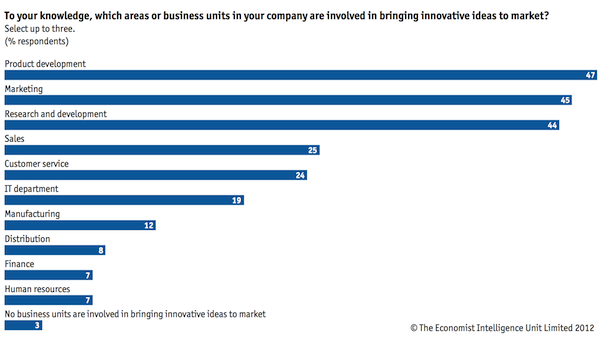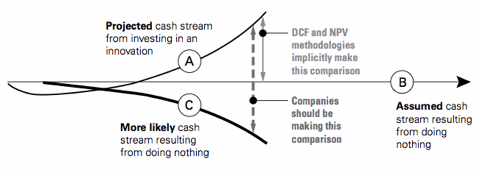You may have heard of the recent report by the Economist Intelligence Unit, Cultivating Business-Led Innovation. The big conversation nugget that has been appearing on a number of marketing industry sites is the survey result stating that more than twice as many executives cite marketing as involved in bringing innovative ideas to market than IT.

Yes, 45% of senior executives say marketing is involved in birthing innovative ideas, but only 19% say their IT teams are.
Now, as much as I’m a champion for the marketing department, this doesn’t seem like an entirely fair way of framing departmental contributions to innovation. Since marketing is generally involved with bringing most things to market, you can’t necessarily credit them as being the driver of that innovation. And on the other side, IT may not need to be involved in many of those launches. You can’t infer that IT is less innovative than marketing from this data.
That being said, I do think IT has a tougher time being the champion of innovation. That’s not due to any lack of passion or brilliance on their part. It’s simply because the IT function in most companies has been tasked primarily with responsibilities for cost efficiency, security, and reliability — missions that largely give them incentives to stick with the tried-and-true.
This actually leads me to the part of the Economist’s report that I find more insightful.
Those same executives were asked, “In your opinion, what are the overall barriers to innovation in your organization?” The top answer, by far: too much focus on short-term financial performance. 48% of the respondents identified that as a barrier. The next nearest answer, too much focus on existing products and services, was picked by 37%. (Interesting side note: lack of IT support was chosen by only 13%.)

This is Clay Christensen’s classic innovator’s dilemma. In the short term, it almost always makes more financial sense to stick with the status quo. In the long term, that’s almost always a recipe for extinction.
I wrote a few years ago about how finance hobbles marketing innovation and referred to this graph from an article Christensen wrote:

It illustrates how net present value (NPV) and discounted cash flow (DCF) calculations can falsely lead decision-makers to overestimate the value of the status quo and underestimate the importance of innovation for the future. Since the future is, regrettably, hard to predict, the “known quantities” of the present can be used — and ultimately abused — to argue against investing in innovations that don’t offer clear short-term financial advantage.
Of course, if you wait until someone else proves the financial advantage of an innovation over the long term — bzzzzt! — it’s game over.
But it occurs to me that marketing may provide a vehicle for escaping this trap.
There are three pieces to this:
- Marketing is increasingly in the business of creating customer experiences.
- Marketing is expected to champion innovation in the worldview of executives.
- Marketing doesn’t have to show short-term financial performance for all its initiatives.
For more discussion of the first point, see my post on everything is marketing, everyone must be agile. The short version: in the digital world, the line between marketing something and actually delivering it has blurred and vanished. The best marketers are now actively involved in crafting customer experiences and are eager to apply innovative ideas in that mission.
The second point is supported by this Economist report — marketers are viewed as linchpins in getting innovation to market. Political air cover as a result of popular perceptions helps.
But the third point is maybe the most interesting. Ever since Wanamaker’s classic chestnut — I know half of my advertising is wasted, I just don’t know which half — marketing has been the butt of jokes about its lack of quantifiable contribution to financial results. Historically, marketing has been viewed as an expense.
For many, this has been “bug.” In fact, the measurability of digital marketing — at least its first-order effects — has been warmly embraced as a way to fix that bug. I’ll be the first to testify that conversion optimization is a wonderful thing. Yet even with all the advances of the performance marketing movement, most companies still have fuzziness around the exact value of different marketing efforts. Just because you can measure the number of followers you have on Twitter — and can generally agree more is better — doesn’t mean you can put a dollar value on them.
But with the innovator’s dilemma, I’m starting to think that the financial fuzziness of marketing may be a feature, not a bug. At least in some cases.
Because marketing can’t accurately report the financial return of every single initiative in which it engages, much less predict such returns in advance — and nobody expects them to — they’re in a unique position to invest in innovations without constantly getting trapped by short-term NPV arguments.
Now, I’m not saying that marketing isn’t on the hook for performing — certainly they are on an overall basis, and many individual programs do have ROI requirements attached to them. But I am saying that the amount of marketing’s budget that is more discretionary in nature can be a large pool of fuel for innovation.
And now that marketing is applying its resources towards customer experiences, their innovations may actually be the forerunners of new kinds of products and services. For instance, marketing might produce an iPhone/Android app for customers because it believes that is the future — even if it can’t prove it. In the short term, they can simply argue that it is important for present-day branding and competitive differentiation. But getting that valuable NPV-free window into nurturing a new kind of relationship with customers may grow and blossom into something much greater over time.



After reviewing the Lean Startup method(s), I’ve come to the same conclusion that marketing is a primary (if not the primary) role/function a ‘new innovator’ a.k.a. entrepreneur must master. Innovators who have been ‘around the the block ‘can probably survive as their channels are already established, but mastering the new marketing technologies available in order to distribute a product or service is not only cost effective, but imperative. I agree, “marketing is involved in birthing innovative ideas” and the data verifies: “#1 barrier to innovation – Too much focus on short-term financial performance-but we have to play the game..right?
As a BA and and social entrepreneur, I’m looking forward to tying this all up nicely into a mobile technology-hopefully solve a few world problems at once! Great post and site, I’m a Fan..J
Set up a separate organization away from the mainstream organization. One which is small enough to be excited about the initial modest gains in sales, profitability and market share.